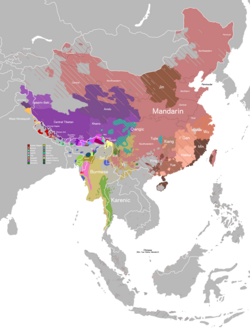You can help expand this article with text translated from the corresponding article in Nepali. (August 2018)Click [show] for important translation instructions.
|
| Jirel | |
|---|---|
| जिरीबे केचा, Iriwe Kecha, སྤྱི་རི་བེ ཀེ་ཅ་, ziribe Ketsha | |
 'Jirel' in Devanagari and Tibetan scripts | |
| Native to | Nepal, India |
| Region | Nepal, Sikkim |
| Ethnicity | Jirel |
Native speakers | 140,000 (2011 & 2021 census) [1] |
| Tibetan, Devanagari | |
| Official status | |
Official language in | |
| Language codes | |
| ISO 639-3 | jul |
| Glottolog | jire1238 |
| ELP | Jirel |
Jirel is a Southern Tibetic language of Nepal. It is spoken in Jiri, in Tshetrapa village, Jungu village, and Cheppu village of Dolakha District and Sindhupalchok and different parts of Nepal.
Contents
It has long been in discussion that the Jirels are the bonpos as other tribes from Tibetan origin people. But after several observations Jirels are seen close to Tibetic Bodish origin rather than Himalayish of Tibeto Burman branch. Very weak literature without evidence is presented by some authors until now claiming that they are the Kirats. They have claimed that they are animists practicing worship of nature, ancestral Spirits and deities close to ancient bonpoism. They have adopted minor cultural and religious practice from Sunuwars and Sherpas when they began to live and share with them. The language they use is the most powerful evidence that they come from a Tibetan ethnic tribe. Their physical appearance, height, make and family name are also supporting evidence for Tibetan origin.
Previously they were animists and until now they practice animism in different ritual performances.They mainly practice Buddhism. Lamas are their priests. They also have Shamans who are called Phonbo, which is derived from the word, Bon, the Tibetan Tantric philosophy.
Jirel Uchen, which is also called Sambhota Script, is their script or calligraphy. This can be found at religious monuments like Ngasas (Chautara), chortens, and monasteries. Jirel Lamas use this script. The script is shown below:
| ཀ ka [ká] | ཁ kha [kʰá] | ག ga [ɡà/kʰːà] | ང nga [ŋà] |
| ཅ ca [tɕá] | ཆ cha [tɕʰá] | ཇ ja [dʑà/tɕʰːà] | ཉ nya [ɲà] |
| ཏ ta [tá] | ཐ tha [tʰá] | ད da [dà/tʰːà] | ན na [nà] |
| པ pa [pá] | ཕ pha [pʰá] | བ ba [bà/pʰːà] | མ ma [mà] |
| ཙ tsa [tsá] | ཚ tsha [tsʰá] | ཛ dza [dzà/tsʰːà] | ཝ wa [wà] |
| ཞ zha [ʑà] | ཟ za [zà] | འ 'a [ʔà] | ཡ ya [jà] |
| ར ra [rà] | ལ la [là] | ཤ sha [ɕá] | ས sa [sá] |
| ཧ ha [há] | ཨ a [ʔá] |

The similarity of Jirel language that with the language used in Buddhist holy books is another powerful evidence to claim and believe that they are of Tibetan origin. It is believed that more than 80 percent of Jirel diction goes with Tibetan language where only 35–40 percent of diction is found to be close to other Tibetan origin tribes.Their language is similar to Dolpos, people in Mugu, Hyalmus, Sherpas, Syubas, Lhomis.
